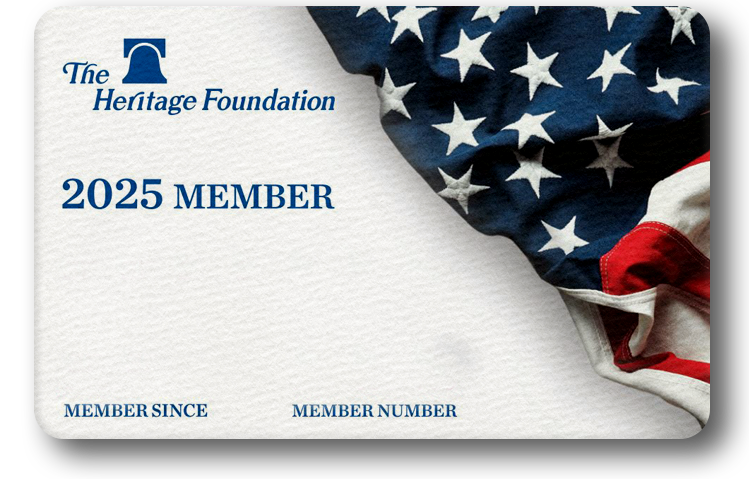The United States cannot regulate its way to educational excellence.
—Tom Loveless, education researcher
Franklin Roosevelt served as Assistant Secretary of the Navy during the Woodrow Wilson Administration. As President, Roosevelt quipped that he served as his own Secretary of the Navy. The leaders of the Navy did not appreciate what they viewed as presidential meddling, engaging in a variety of tactics ranging from passive resistance to outright refusal to follow Roosevelt’s direction.
After the attack on Pearl Harbor, Roosevelt’s hands-on approach found vindication. Roosevelt had ordered the Navy to convert light cruisers into makeshift aircraft carriers over the sustained objections of the admiralty—a decision that proved both wise and desperately needed as the United States found itself down to a single functional large carrier for long periods of the Pacific War. Along the way Roosevelt noted to a friend:
The admirals are really something to cope with—and I should know. To change anything in the navy is like punching a feather bed. You punch it with your right and you punch it with your left until you are finally exhausted, and then you find the damn bed just as it was before you started punching.REF
The interwar Navy has nothing on America’s public education system. Presidents, Members of Congress, Governors, philanthropists, and those who run non-profit organizations have been punching the feather bed of public education for decades. Even before the calamity of the COVID-19 lockdowns, Americans had little to show for their effort.
The Dismal Results of K–12 Reform
Over the past two decades, all 50 states increased per-pupil funding and adopted academic standards and accountability exams. Chart 1 shows the spending trend (inflation-adjusted) per pupil by state between 1999 and 2000. Increases ranged from a low of 5 percent in Idaho to 101 percent in Vermont. The average state increased funding by 37 percent above inflation.
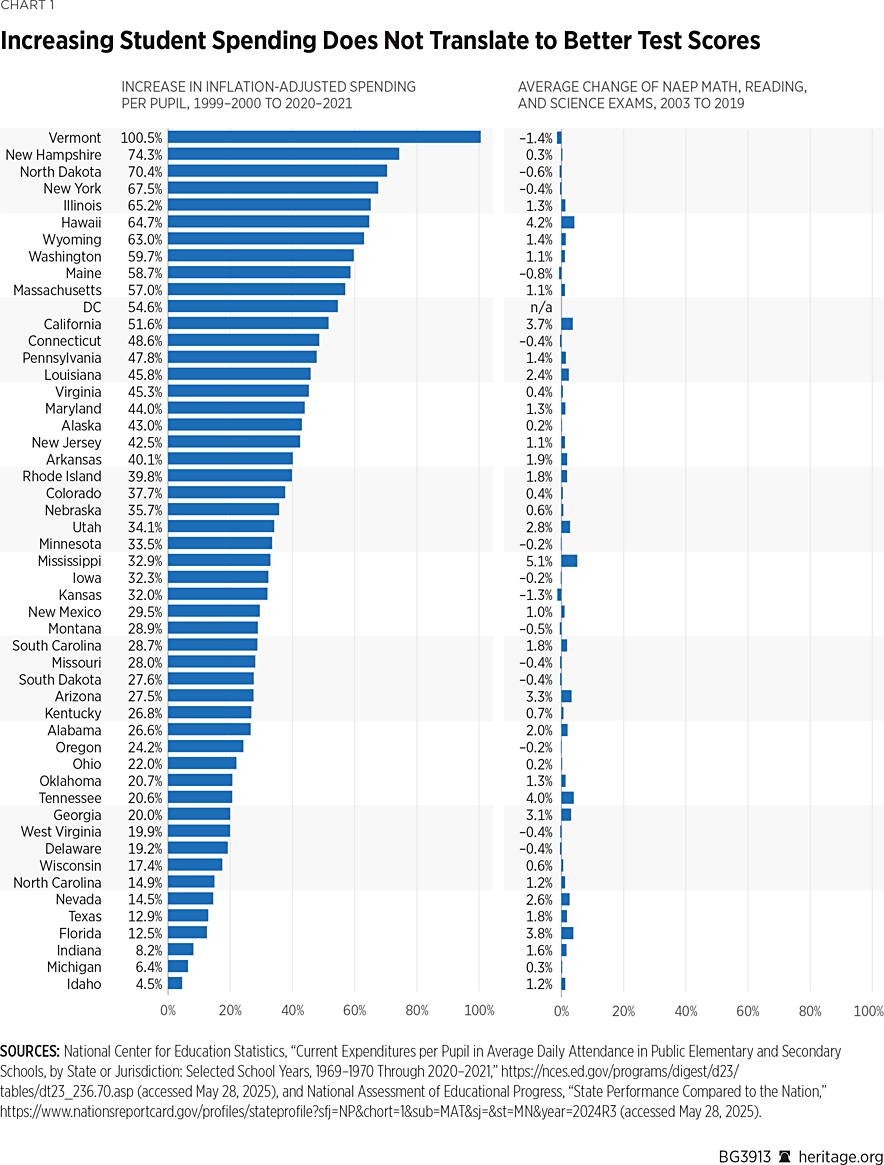
Research established long ago that funding increases do not automatically translate into improvements in academic outcomes.REF Did states, however, see any return on investment for their increased spending in the form of improved academic performance?
The National Assessment of Educational Progress (NAEP) is a widely respected set of academic exams given to representative samples of students in all 50 states. Tests include fourth-grade and eighth-grade reading and math for all states between 2003 (the year when federal law required states to participate in those tests) and 2019 (the last NAEP data before the COVID-19 pandemic). A large majority of states also participated in fourth-grade and eighth-grade science exams between 2009 and 2015, with the next science exams scheduled for 2028. Federal law does not require state participation in the science exams, and for non-participating states the average represents only the NAEP exams in which they participated. Chart 2 presents the NAEP improvement for the states from 2003 to 2019 (with 2009 to 2015 science results included for participating states), with the national average equaling only a 1 percent improvement in scores.
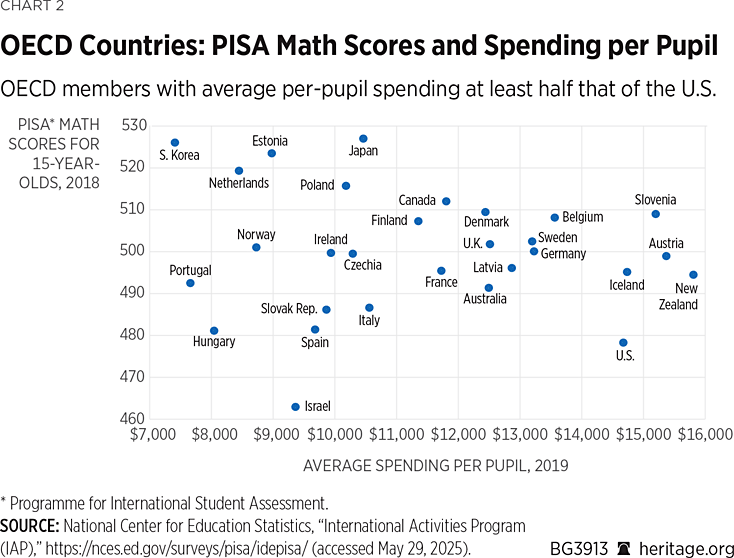
Vermont had a 101 percent increase in spending per pupil beyond inflation only to see its NAEP scores decline—making Vermont students, families, and taxpayers the biggest losers during this period. Idaho meanwhile had the smallest increase in inflation-adjusted spending per pupil (5 percent) and managed to improve its scores by an amount equal to the national average (1 percent). This data came before the COVID-19 school-closure debacle; updating these figures for the 2022 NAEP provides even worse academic outcomes.REF
While there is evidence of academic gains in states that lacked policies for standards and testing before federal requirements, those gains were not sustained over time.REF In essence, the federal government tried and failed to spend and regulate its way to better K–12 outcomes.
International examinations of student achievement also have disappointing results for American students. Among countries that spend at least half as much per pupil as the United States (29 countries), America scored below all but one. (See Chart 2.)
The wide variety of reform efforts—from standardized testing to teacher evaluation, and more—broadly failed to move the needle on achievement for one basic reason: politics. Stanford Professors John Chubb and Terry Moe had called out the failure of regulatory reform in 1990, with Moe later explaining:
Reformers were dedicated to bringing fundamental change to public education. But the teachers unions, driven (as all unions are) to protect the occupational interests of their members, found real change to be threatening and used their enormous power to try to prevent it. Throughout, they were aided by the checks and balances built into American government, which made new laws difficult for reformers to enact—and relatively easy for powerful opponents to block.
Over the decades, the unions proved to be maestros of political blocking. When “reform” happened, it was almost always because the unions had opened the political gates for mainstream efforts that they found acceptable: greater spending, smaller classes, higher standards, more professional development, and the like. Reforms that promised major change were either blocked entirely, or they were so weakened that their potential was never seriously tapped.REF
The data presented in Charts 1 to 2 are entirely consistent with the above statement. Worse still, decades into the accountability movement, surveys indicate that 89 percent of American parents believe that their children are at grade level in math.REF Yet, the national percentage of students scoring “Proficient or Better” on the NAEP eighth-grade math exam peaked at 35 percent in 2013 and stood at 26 percent in 2024. The current practice of standardized testing thus has very limited diagnostic value to parents.
Policymakers will need to update their accountability strategies to avoid repeating the errors of the past. The “accountability” systems developed in the early 21st century may be worse than useless. They may, in fact, serve as weapons of mass deception. What Chubb and Moe aptly described as “political blocking” finds American families and taxpayers, decades later, with state “accountability” systems with very few individuals held responsible for academic failure. Students, parents, and families require a robust form of bottom-up accountability which the “maestros of political blocking” can no longer block. This will require updating accountability practices from weak and easily undermined into robust and decentralized.
In retrospect, the era from 2000 to 2016 appears to be one of well-meaning but misplaced faith in K–12 managerialism—a herculean effort that failed to realize its ambitions due to some predictable political realities. Reformers of that era brought a technocratic knife to a political gunfight.
Accountability efforts began to take shape in multiple states before federal law created federal mandates with the passage of the No Child Left Behind (NCLB) Act in 2002. President Trump campaigned on closing the federal Department of Education during his most recent run for President—and is actively pursuing enacting this pledge at the time of this writing. While the federal government requires schools to adopt academic standards and to test students, states have always remained entirely free to create their own state accountability systems. Many of these predated the NCLB Act and some continued unchanged after its passage.
Hope for a more robust system of accountability, however, endures. The following pages demonstrate the weakness of state school-rating systems, and the relative strength of private, non-government-based school-rating systems. Yet, private rating systems will only create meaningful accountability when paired with robust school options. The future of “accountability” lies in voluntary association and exchange where parents can direct funding to the school or education method of their choice. Transparency in the form of broad rating systems (including but going beyond schools to include various education service providers and products) combined with robust education choice can finally create meaningful accountability in K–12 education.
Accountability 1.0
In the late 20th century, a broad bipartisan consensus developed on state academic standards and test-based accountability for K–12 schools. On the surface this coalition seemed enormously powerful. By the early years of the 21st century, this consensus stretched from Senator Ted Kennedy (D–MA) to President George W. Bush. Major philanthropists backed a powerful coalition for reform. A great deal of disagreement on other schooling issues (such as parental choice including private options) coincided with the consensus on the broad support for the idea of having state academic standards and associated tests and choice in the public sector through charter schools.
As Texas Governor, George W. Bush defeated Vice President Al Gore in the 2000 presidential election and pursued education reform as his primary domestic policy goal of the first of his two terms. The NCLB required states to test students with exams linked to state standards and to disaggregate results by student subgroups. The statute contained a menu of sanctions for public schools failing to achieve Annual Yearly Progress (AYP). Sandy Kress, one of the architects of the NCLB strategy, explained:
School districts and campuses would be held responsible by policymakers and taxpayers if they did not provide a decent education for every student. This idea came to be known as school accountability, and it was built around three principles: Creating rigorous academic standards, measuring student progress against those standards, and attaching some consequence to the results.REF
For years after the passage of the NCLB Act, both major American political parties endorsed test-based accountability in their platforms. The 2004 Republican Party platform proclaimed: “Results are now measured on the basis of student achievement rather than simply dollars spent.” The Democratic Party platform, not to be outdone, stated that “we must create rigorous new incentives and tests for new teachers. We need new rewards for teachers who go the extra mile and excel in helping children learn. And…we must have fast, fair procedures for improving or removing teachers who do not perform on the job.”REF
Noble sentiments in both cases, but the ambitions of this period failed to materialize in practice. The supporters of test-based accountability had good intentions, believed in the justice of their cause, and fought hard for what they believed to be right. The opponents of test-based accountability, the education unions and their allies and proxies, proved to have greater staying power and found the subversion of state accountability systems a manageable task overall.
With a sad but consistent predictability, state accountability systems failed to hold many adults meaningfully accountable. Many states responded to NCLB proficiency requirements by adopting lower score requirements to achieve “proficiency” and often backloaded progress requirements into the future, confident that these requirements would be eliminated.
Given that states respond to the preferences of organized interests in pluralistic systems of interest group competition, this outcome was foreseeable, perhaps inevitable. District interests—unionized employees, school board associations, school officials, and more—organized decades ago and command active memberships, vast financial resources, and many lobbyists. While these interests were not able to prevent the passage of the NCLB Act, subverting it in implementation proved to be relatively simple.
Critique of NCLB, however, did not exclusively originate from teacher unions and their fellow travelers. Arizona Superintendent of Public Instruction Tom Horne, a Republican elected statewide leading the state’s department of education, offered the following critique of the federal school rating system:
The federal system divides the world into nine ethnic and other subgroups and tests two subjects, in seven grades, with two measures: percent proficient and whether or not at least 95 percent were tested. If a school falls below standard on any one measure, the entire school fails, no matter how well the school did on all of the other measures.
With all of these categories, how many combinations and permutations are there? How many ways are there to fail? To pass the Arizona high school high-stakes math exam, you would have to know the formula for that. You multiply the numbers together: 9 x 7 x 2 x 2 = 252. There is an additional measure that varies by states. That makes a total of 253.
I call this the 253 ways to fail system. If a school falls short on one (let’s say it tests 94 percent rather than 95 percent of fourth grade special education students) and succeeds spectacularly on the other 252 (the highest test scores in the state), the entire school still fails.REF
Supporters of NCLB defended the goals of the statute as tools to spur academic improvement and noted that the consequences for failing to meet the AYP were far less than draconian. Critics viewed the goals as unrealistic and worked to both change and undermine them. The states that deferred their higher proficiency requirements into the future made a shrewd and winning bet, as Congress did indeed eliminate the requirements during the reauthorization that occurred during the Obama Administration.
Simultaneously, large elements of the standards and accountability movement attempted to create and promote common state academic standards and examinations. Two state consortia developed Common Core standards, and the federal government provided incentives for state adoption of these standards, which many found both inappropriate and alarming. Substantial amounts of philanthropic, taxpayer, and political capital went into the Common Core effort, but it resulted in sparking a grassroots rebellion and produced little to nothing in the way of academic benefit.REF As Tom Loveless from the Brookings Institution succinctly put things in summarizing the lack of academic payoff from Common Core: “The United States cannot regulate its way to educational excellence.”REF
States began dropping out of both Common Core consortia and, as of this writing, most states do not participate. Academic performance nationwide lagged after 2009 and substantially dropped in 2022 in the wake of the COVID-19 pandemic response. As seen in Charts 1 and 2, spending per pupil raced ahead while academic performance only modestly improved before plunging in the aftermath of the pandemic shutdowns.
The unions and their allies do not simply possess a great deal of raw political power, they also have a record as powerful and skilled bureaucratic in-fighters. One can see an example in state policies that grade schools A, B, C, D, or F based on performance. Unlike the NCLB provisions, state policymakers developed this practice in Florida and subsequently adopted it in multiple states. Like for the NCLB provisions, the guardians of the K–12 status quo have not always been able to prevent school-grade statutes from passing, but they have proven quite adept at either repealing or undermining them.
Federal law requires states to give academic exams and to subsequently label public schools based on their performance. The case for creating a system on an A to F scale that people can understand, rather than using fuzzy labels, such as “performing” or “performing plus” which people cannot interpret without knowing the rank scale of terms, therefore seems strong. Moreover, the original Florida grading model placed a premium on the academic learning gains of low-performing students, which may have played a role in spurring academic improvement in the years after adoption of the practice in 1999.REF
Several jurisdictions, however, adopted A to F letter grades for public schools only to subsequently drop them—including Georgia, Michigan, Ohio, Utah, and New York City. Moreover, many of the states that have continued the practice have not maintained the integrity of the system over time. Texas uses letter grades for schools, but only rates schools A to C, or “not rated,” making them not comparable to other systems. Chart 3 shows the distribution of school letter grades in Alabama, Arizona, Florida, Mississippi, and North Carolina.
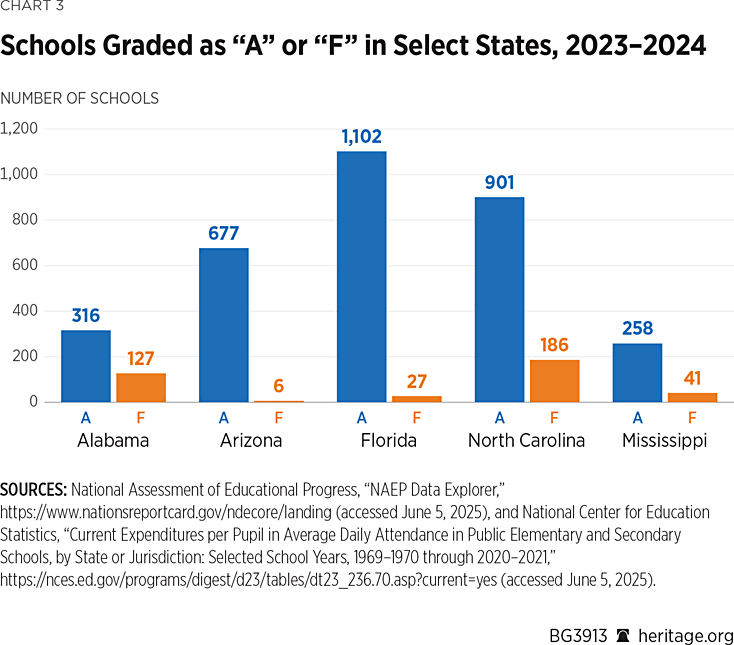
Alabama comes in as the tough grader in the group, with 2.48 A grades awarded for every F-rated school. Arizona lies on the opposite end of the scale with almost 113 A grades awarded for every F grade. Some of these systems may be more useful than others. There is no use, however, in maintaining the false hope that “trophies for everyone” state accountability systems will be driving academic improvement.
Education Choice 1.0
State adoption of charter school laws was a junior partner to the accountability movement during the bipartisan reform era of the early 2000s. Bipartisan reformers viewed charter schools as less controversial than private choice programs. Charters operated without attendance boundaries and states funded them on a per-pupil basis, which created opportunities for educators to create their own schools and for parents to choose among schools.
By the fall of 2021, 7 percent of American public school students attended charter schools. State charter school sectors vary widely in size, with the largest being Arizona, where around 20 percent of public school students attend charter schools. States in the Southwest alone reached at least 10 percent of public school students in charter schools by 2021—with only Florida, Louisiana, Michigan, and Pennsylvania having hit the 10 percent threshold outside the Southwest. (See Map 1.)
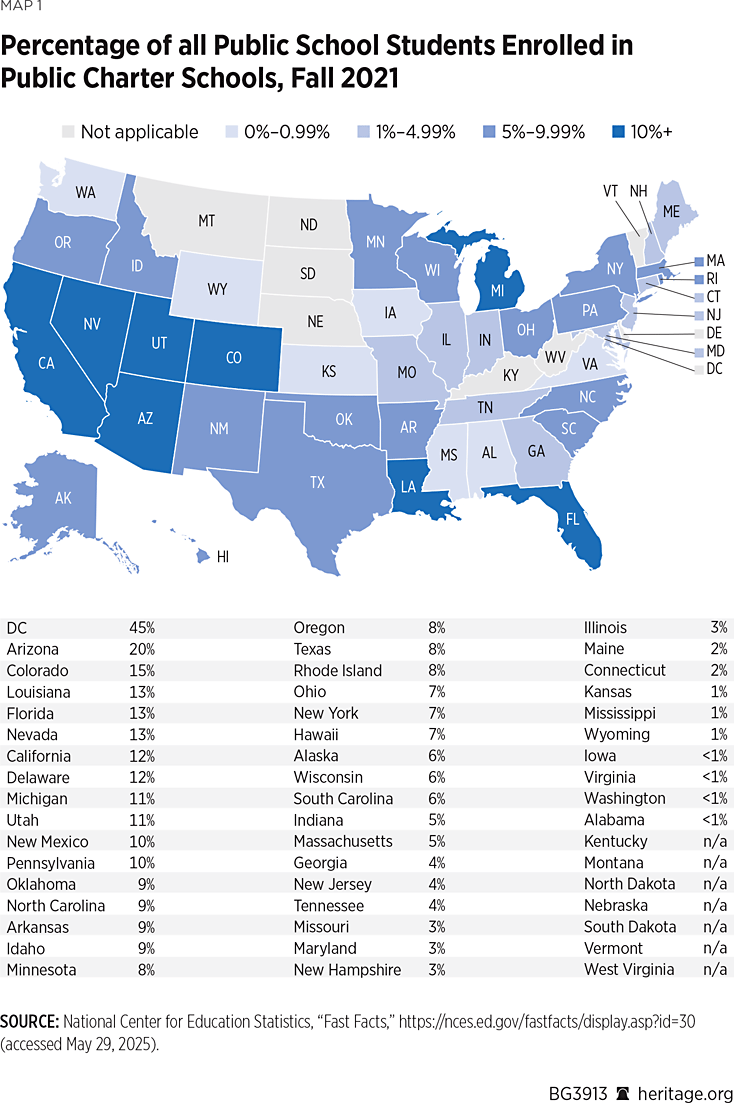
Charter schools typically receive less per-pupil funding than their district peers and must finance their facilities with per-pupil funding—one of the larger, but hardly the only, practical challenge to scaling a charter sector. Charter schools, however, face a great many legal challenges, including authorization regimes and other red tape resulting in minimal new school openings.
Even in Arizona, getting to 20 percent of charter school attendance happened over almost three decades. Nationally, charter school waitlists remain a common phenomenon—indicating that the demand for charter seats remained persistently greater than the supply. Because of both political and practical constraints, the charter movement never proved able to be fully capable of meeting that demand.
It is difficult to pinpoint when exactly the bipartisan consensus on education reform ended, but the evaporating support among Democrats for charter schools represented a real-time shift. President Barack Obama won the 2008 Democratic primary without the support of teacher unions (which endorsed Hillary Clinton). President Obama supported charter schools. Joe Biden, Obama’s Vice President, became overtly hostile to charter schools both rhetorically and substantively upon becoming President. A 2024 post by Bellwether Education’s Andy Rotherham about the weakened support for charter schools among Democrats captures the zeitgeist of post-bipartisan education reform:
Charters offered less regulations, could be universal, but they had key elements of publicness. They were an outpost for Democrats and a way station for Republicans. The ground has shifted and post-pandemic the energy is with rapidly expanding choice.
This perhaps would not be such a big problem for charters if they enjoyed a strong base of support in the Democratic party and were genuinely bipartisan in 2024. But they don’t. They’re not. Sure, there are still some pro-charter Dem governors, but Joe Biden cut the public charter school program at the Department of Education in his budget. Tells you what you need to know. Charters enjoy support among base Democratic voters, but not among elites and powerbrokers.REF
A summation of Accountability 1.0 and Education Choice 1.0: Families and taxpayers received some academic information about their public schools, but that information was put through a highly politicized filter. While options for parents who wanted to act on information about their child’s school grew over time, they remained severely constrained. While meaningful variation in charter growth occurred at the state level, waitlists developed in all states and eventually the unions defeated their reform-minded opponents within the Democratic Party.
Fortunately, improved transparency and Education Choice 2.0 have already launched and could avoid past mistakes.
Transparency + Navigation + Options = Meaningful Accountability
State school rating systems have become increasingly irrelevant over time, for two basic reasons. First, private firms developed private school information platforms, and those private platforms have proven to be much tougher graders than state systems. For example, the Great Schools websiteREF ranks schools on academic performance on a one-to-10 scale, with “1 out of 10” being the lowest rating, and “10 out of 10” being the highest. Chart 4 equates the five-point A-to-F scale to the one-to-10 scales (ratings of nine and 10 equating to an A, one or two to an F). It shows the state of Arizona’s grades for public schools in Maricopa County (the county containing Phoenix) according to the Arizona Department of Education and in the Great Schools platform for public schools in Phoenix or within 15 miles of Phoenix (the closest approximation of Maricopa County available). The number of schools does not match, but which system gives tougher grades is clear.
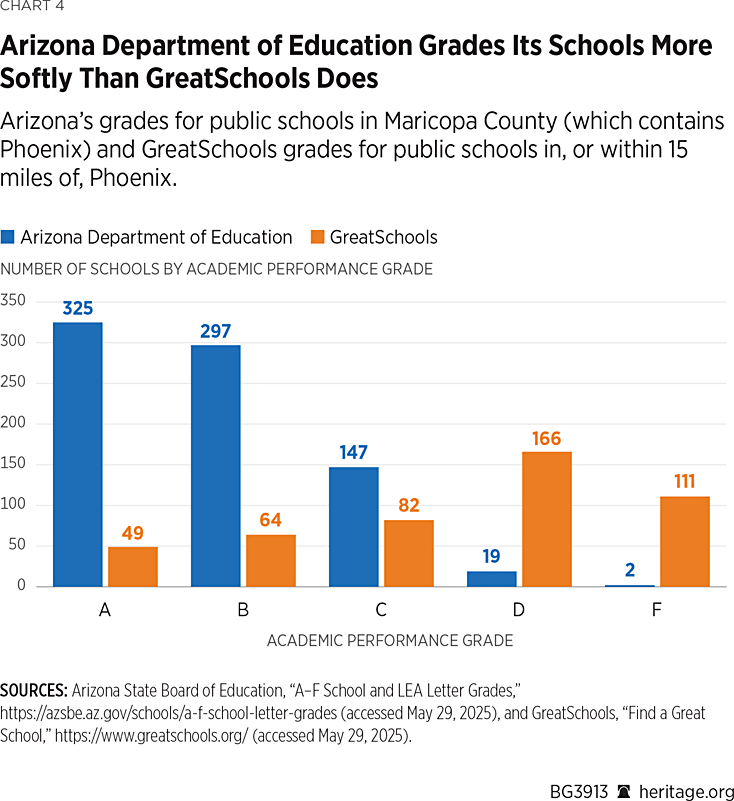
Is it more likely that only 0.25 percent of Phoenix area schools deserve the lowest possible academic ranking, or does 24 percent seem more likely? Great Schools, based on these two samples of schools, appears to have a willingness to label schools with the equivalent of an “F” at more than 90 times that in the state of Arizona.
Parents have access to rankings in addition to Great Schools that can corroborate these findings, such as Niche.REF Like Great Schools, Niche collects school reviews from parents and students in addition to providing much more credible rankings of academic performance. Experimental research demonstrates that school reviews have a substantial impact on perceptions of schools with identical academic information presented.REF Private-school-navigation websites collect such reviews, state rating systems do not.
Public school ratings do not represent the first time that a rating system run by public officials failed, but multiple private rating agencies have successfully replaced this failed state effort. In the early 20th century, the state of New York established the New York State Kosher Enforcement Bureau—to certify food as kosher under Jewish religious tradition. Predictably, this exercise quickly devolved into a fiasco; opinions varied widely about what constituted kosher food. As Heritage’s Jason Bedrick noted,
by the 1930s, the Bureau proved unable to properly oversee the roughly 18,000 kosher food establishments under its jurisdiction. Moreover, arguments erupted between numerous Jewish factions over how the state agency should interpret kosher law or whether it should be in the business of interpreting Jewish law at all.REF
A system of more than 300 private kosher food rating agencies replaced the doomed effort to have state officials rate religious compliance. Private certification represents a more realistic option, as it allows the consumer to select varying interpretations of kosher standards.REF It is difficult to say these many years later that many—if any—states have done a better job of certifying schools than the state of New York did in certifying kosher food. Given that the United States has 300 private organizations for certifying kosher food, an expanded number of private firms to inform parents about schools seems both appropriate and inevitable.
The New York State Kosher Enforcement Bureau, at least, knew when to throw in the towel—which is more than one can say for state school ratings thus far. What if the federal government had mandated state kosher ratings? What if these efforts, to varying degrees, followed the New York experience, with standards deemed unreliable and controversial? Finally, what if those state rating systems were generally ignored in preference to private rating systems, which had the advantage of being more pluralistic and reliable? If all three of these imagined conditions were true, the situation would be like what happens with “academic accountability” today. To the limited extent that America’s student testing requirements are holding adults accountable for results, it is mainly through private platforms assisting parents to make decisions about where to send their children to school. Charter school waitlists, however, were the most obvious sign of an inability of Education Choice 1.0 policies to create sufficient supply to meet demand.
The next generation of choice policies will also require enhanced rating platforms. In recent decades “school choice” has evolved into “education choice” with parents not only selecting among schools, but also education methods. Americans have engaged in supplemental education for decades. Enrichment in various forms, such as tutors, club sports, tutoring services Kumon and Mathnasium, and more, has become increasingly ubiquitous—with the biggest increases among upper-income families—over recent decades. Researchers Greg Duncan and Richard Murnane tracked private-enrichment spending per child and compared the trend among top-income families to those in the bottom quintile, presented in Chart 5.
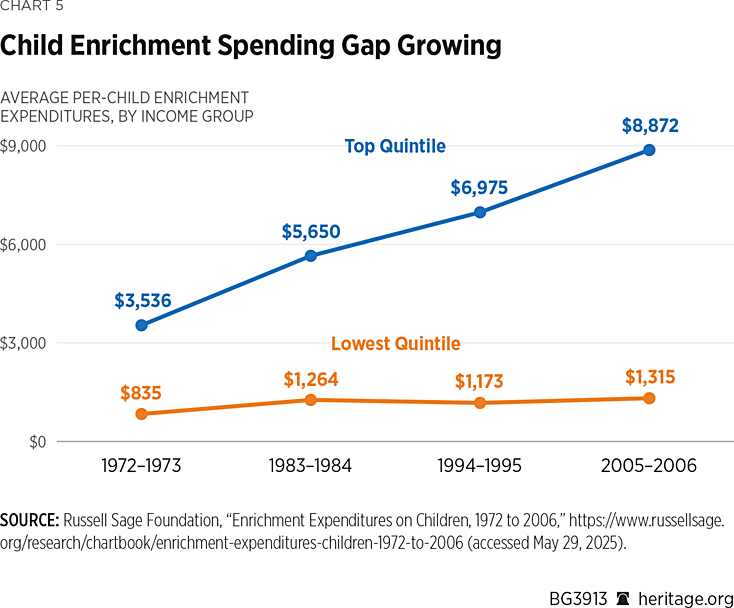
Lower-income families also spend money on enrichment, but this happens at a much lower level and the trend has been flat. Families in the upper quintile of income meanwhile steadily increased their enrichment spending over time.REF Subsequent research found the enrichment spending gap to be largest for enrichment activities, such as music lessons, travel, and summer camps.REF A next generation of education savings accounts (ESAs) and personal use tax credits have expanded the reach of families in a growing number of states to engage in multi-vendor education.
Because of the increasing spending outside of schools, one cannot be certain of the degree to which high-performing schools enjoy this status because of the actual efforts of the school as opposed to the private enrichment activities of families. Further, families hold the vast universe of enrichment vendors accountable in the standard fashion: through voluntary association and exchange. Vendors develop reputations that users convey by word of mouth; parents employ their social networks to gain recommendations that were not funneled through a politicized government rating system.REF
Higher-income American families continued to primarily enroll their children in public schools—but these families were able to afford to live in the ZIP code of a high-demand public school and to afford ever-increasing enrichment spending. Despite paying such premiums, the number of higher-income families solely relying on those schools declined over time as higher-income families spent increasingly on private enrichment. Over time, they engaged in more enrichment. Slowly, a leading edge of pioneers began to experiment with the idea of enrichment replacing custodial schools.
Wired magazine reported on this trend among Silicon Valley families as early as 2015 in an article titled “The Techies Who Are Hacking Education by Homeschooling Their Kids.” Although no one had yet coined the term “pandemic pod,” Silicon Valley families were practicing them before the pandemic. “There is a way of thinking within the tech and startup community where you look at the world and go, ‘Is the way we do things now really the best way to do it?’” The author quoted an observer of this emerging trend: “If you look at schools with this mentality, really the only possible conclusion is ‘Heck, I could do this better myself out of my garage!’”REF A far larger universe of parents adopted these practices during the pandemic lockdowns.
Trends often start among elites and then democratize out to the broader population. Research on the prevalence of baby names, for instance, shows that popular names first became so among high-income Americans before becoming broadly popular. Free-wheeling multivendor homeschooling co-operatives (co-ops) starting in Silicon Valley and then spreading fits the pattern.
Resources, such as Great Schools and Niche, provide valuable information on public schools, but little on private schools and nothing on the broader universe of co-ops, micro-schools, and non-school-based educational opportunities.
A project known as MatchED aims to create a system of reviews, scheduling, and payment for the permissionless education space:
The growth of homeschooling and microschools (now over 6M children nationally), supplementary educational services (tutors, test prep, camps, etc.) and school choice (ESAs, vouchers, tax credits) has created a large market of educators/parents with full flexibility to personalize learning. However, it is very overwhelming and challenging to sort through all the options to find the right fit for their child. MatchED will build and operate technology-enabled matching platforms to create low-friction, high-value matches between producers and consumers in education to make the new era of “matching” education easier and better.REF
Under the antiquated 20th-century model of “accountability” one might expect a regulatory body to “certify” piano instructors. If set up as a board, more often than not, an incumbent set of “certified” piano instructors would quickly take control to limit the number of people who are allowed to teach piano.REF
By contrast, user reviews, which judge the quality of goods and services in many other aspects of life, represent the future of education transparency.
In addition to MatchED, a number of nonprofit organizations have emerged to help families to navigate choices among schools and among schooling methods around the country. Lawmakers may include K–12 navigation services as an allowable expense under ESAs and under personal-use tax-credit programs in the future. Multi-vendor K–12 education remains in an early adopter stage, so the institutions surrounding these practices remain under development.
The K–12 landscape of 2025 has begun to catch up to the vision of K–12 school choice pioneers Jack Coons and Stephen Sugarman, whose 1978 book Education by Choice foresaw a system of multi-vendor education and navigation. Coons and Sugarman envisioned parents, including low-income parents, having the power to create “personally tailored education” for their children, using “divisible educational experiences.” This sounds remarkably close to ESAs and multi-provider education:
To us, a more attractive idea is matching up a child and a series of individual instructors who operate independently from one another. Studying reading in the morning at Ms. Kay’s house, spending two afternoons a week learning a foreign language in Mr. Buxbaum’s electronic laboratory, and going on nature walks and playing tennis the other afternoons under the direction of Mr. Phillips could be a rich package for a ten-year-old. Aside from the educational broker or clearing house which, for a small fee (payable out of the grant to the family), would link these teachers and children, Kay, Buxbaum, and Phillips need have no organizational ties with one another. Nor would all children studying with Kay need to spend time with Buxbaum and Phillips; instead some would do math with Mr. Feller or animal care with Mr. Vetter.REF
During the same period in which President Jimmy Carter was creating a centralized federal Department of Education (the source of some funding and much paperwork and regulation), Coons and Sugarman envisioned a radically decentralized education system with families and educators in charge. Coons and Sugarman called for “living-room schools,” “minischools,” and “schools without buildings at all.” They describe “educational parks” where small providers could congregate and “have the advantage of some economies of scale without the disadvantages of organizational hierarchy.”
Absent the grant system Coons and Sugarman called for, multivendor education flourished among high-income Americans decades ago in the form of private enrichment spending. In the years before the pandemic, enrichment had begun to replace custodial schooling among early adopters, drawing upon the development of the homeschool cooperative. In 2011, the first state choice program accommodating multiple uses outside private school tuition debuted in Arizona with the passage of the Empowerment Scholarship Account program. Arizona lawmakers expanded eligibility for this program, and lawmakers in other states began adopting multivendor choice bills of their own. The pandemic debacle fueled an unprecedented demand shock for K–12 options of all types.
Education Choice 2.0
The COVID-19 pandemic proved to be a game changer in parental demand for choice in education, as Robert Pondiscio of the American Enterprise Institute explained:
In retrospect, the pandemic could not have come at a worse time for traditional public schools. Decades of expensive and intensive efforts to improve public education outcomes at scale have been disappointing and dispiriting. The education reform movement of the past several decades, which began with the youthful, can-do optimism of Teach For America and high-flying urban charter schools, morphed into a technocratic regime of standards, testing, and accountability that proved not just ineffective but deeply unpopular with parents and teachers alike. Even before pandemic-driven “learning loss,” long-term trends in student achievement didn’t match the effort or expenditure devoted to improving student outcomes and closing the achievement gap.REF
During a post-pandemic wave of activity, many states have made progress on choice, and at the time of this writing, that progress continues. Few states, however, have created fully realized, robust systems of choice in multiple forms with a statutory design allowing the supply of choice to grow along with the demand of families. Arizona and Florida acquired robust private choice programs through an incremental process of improving smaller choice statutes. Lawmakers in Arkansas and West Virginia, however, jumped straight into robust private choice with game-changing pieces of legislation.
Program design drives the ability of families to participate in choice programs. To start a school, even a small one, one must secure start-up funding, a facility in which to operate, and staff to create and adopt curriculum and to instruct students. Of course, one must also recruit students. The low-hanging fruit in private choice programs involves filling empty seats in existing private schools, but this will only go so far. Empty seats in existing private schools represent a limited resource. To create a truly demand-driven system of K–12 education, high-demand schools must be able to expand their student bodies and even replicate their schools in other locations. New schools and service providers will also prove crucial for the ability of parents to hold private providers accountable.
In a demand-driven K–12 system, families will use a variety of sources of information, including but hardly limited to the online platforms described above, to select among schools and other education opportunities. Robust choice programs can create an option to exit the public school system, but the degree to which education alternatives exist will rely on three crucial elements—formula funding, expansiveness of uses, and universal eligibility—to create a system where educators can create new schools and services, and families can select among them. EdChoice articulated these issues as crucial to a program living up to the vision of its founder Milton Friedman.REF Each of these elements also has practical uses to help ensure the flourishing of education freedom.
Formula funding assures that every student who wants to participate in education choice has the opportunity to do so, as the state will fund the students’ participation as automatically as if they attended a public school.
Expanded uses allow families to make use of choice programs in ways other than attending private school: college tuition, private tutors, individual public school courses, and more. ESA families have teamed up to hire their own teachers and have enrolled their children in college courses. Expanded uses make it less likely that supply bottlenecks will hamper participants from finding an education which suits them.
Universal eligibility has both practical utility in simplifying program administration and opening seats in high-demand district schools, creating open-enrollment opportunities. In addition to being a pragmatic policy, it is also popular and just. Opinion polls have long revealed greater support for universal choice compared to means-tested programs. Moreover, millions of people pay state taxes earmarked for education, and they should all have the option of participating in every form of K–12 education.
With a formula-funded, universal, and expanded-uses choice program, one would expect an initial surge in enrollment, and then an incremental process of supply expansion in the private school sector not unlike among the small handful of robust charter markets. The twist, however, is the possibility of tapping into a national trend of multivendor education represented by the “pandemic pod” phenomenon. This form of education does not require the costly and incremental process of building new school space.
In 2025, EdChoice identified four states as having programs with all three of these elements: Arizona, Arkansas, Florida, and West Virginia.REF In the case of Arizona and Florida a multi-year process of incremental expansion resulted in programs with universal eligibility, expanded uses, and formula funding. Arizona’s ESA program, for instance, began life as an appropriation-based program exclusively for students with special needs. Florida’s journey to universal choice began with a scholarship tax-credit program with a statewide cap on the amount of total funding.
Many other states have either school vouchers, ESAs, or personal-use tax-credit programs, only one element away from trifecta status. Oklahoma, for instance, could achieve this status by either eliminating the cap on its tax-credit program or by creating a demand-driven mechanism to increase the cap. The new personal-use credit passed in Idaho in 2025 would achieve the same trifecta status with the same reform. Ohio lawmakers could achieve a trifecta by allowing voucher recipients to use their funds for educational purchases beyond private school expenses. New Hampshire lawmakers could achieve trifecta status by increasing eligibility for the Education Freedom Account Program to all New Hampshire students. Many ESA programs could achieve trifecta status by adopting formula funding rather than an annual appropriation.
Conclusion
A well-intentioned bipartisan coalition came together in the late 20th century to spur improvement of the K–12 education system through test-based accountability and public school choice. The ability of this coalition to institute and maintain meaningful “accountability” proved extremely limited. State accountability systems morphed into hollow bureaucratic compliance rituals delivering participation trophies rather than meaningful consequences.
Not all state efforts proved equally futile. Florida’s early combination of robust accountability, financial incentive funding, literacy reform, and expanded choice options saw statewide outcomes improve across a variety of measures. Arizona’s relatively unconstrained embrace of public and private choice options saw the state improve across all six NAEP exams and rank first in the statewide rate of academic growth as measured by the Stanford Educational Opportunity Project. Mississippi and Louisiana have both seen academic improvements in recent years with multi-faceted reform strategies. As Chart 1 demonstrates, however, that the overall NAEP improvement for Arizona, Florida, Louisiana, and Mississippi between 2003 and 2019 stood at 3 percent, 4 percent, 2 percent, and 5 percent, respectively.
Now, a brighter future beckons. Private organizations have supplanted state efforts to rate schools. The guardians of the education status quo cannot easily subvert private organizations, and the public has a greater degree of trust in them. In addition, private school rating platforms collect reviews, which research shows families value. Innovators have begun to expand these platforms beyond schools into a variety of education-service providers and to collect user reviews.
The broadening of choice from an exclusive focus on schools to a broader universe of education methods liberates choice from conventional supply constraints, such as the limited availability of seats in private schools. Accordingly, growth in formula-funded, universally available, and multi-use programs, such as those in Arizona and Florida, have exceeded that of previous choice programs. Top-down accountability disappointed for very predictable political reasons. Bottom-up accountability, which grows a supportive political constituency as it expands, contains a much greater capacity to reward high-demand education service providers.
As Tom Loveless noted, the United States cannot regulate its way to educational excellence. As Franklin Roosevelt noted: “It is common sense to take a method and try it. If it fails, admit it frankly and try another. But try something.” It is long past time to admit frankly that America’s effort to regulate its way to educational excellence has failed and it is time to try something else.
Matthew Ladner, PhD, is Senior Advisor for Education Policy Implementation in the Center for Education Policy at The Heritage Foundation.

